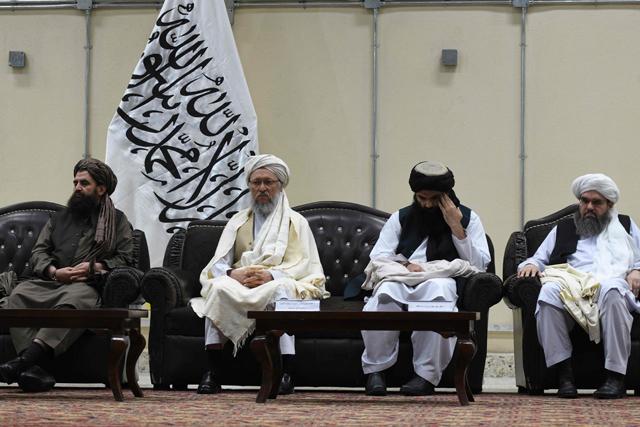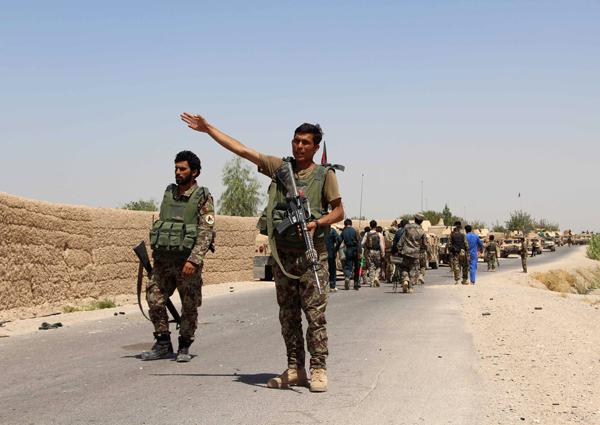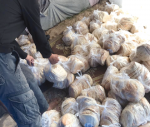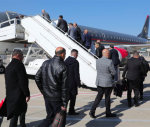You are here
Afghan opium output soars as cultivation hits record high
By AFP - Nov 15,2017 - Last updated at Nov 15,2017

This file photo taken on April 19, 2016, shows Afghan farmers harvesting opium sap from a poppy field in the Chaparhar district of Nangarhar province (AFP photo)
KABUL — Afghan opium producers have had a bumper year with output soaring 87 per cent as the area under poppy cultivation hit a record high, the latest annual survey said on Wednesday.
The price of opium — the lifeblood of the Taliban — as it left farms in war-torn Afghanistan this year soared by 55 per cent to almost $1.4 billion, the UN Office on Drugs and Crime (UNODC) said, helping to fuel the bloody insurgency.
Rising insecurity, lack of government control and corruption were among the key drivers along with unemployment and lack of education, according to the Afghanistan Opium Survey, jointly compiled by the UNODC and Afghanistan’s counter-narcotics ministry.
Potential opium production from this year’s harvest is estimated at 9,000 tonnes, up 87 per cent from the 4,800 tons produced last year, boosted by increased cultivation and better yields.
Over the same period the area under poppy cultivation expanded by 63 per cent to a record 328,000 hectares — topping the previous record of 224,000 hectares in 2014 — with the number of poppy-growing provinces jumping to 24.
Only 10 Afghan provinces are now considered poppy free.
“The significant levels of opium poppy cultivation and illicit trafficking of opiates will probably further fuel instability, insurgency and increase funding to terrorist groups in Afghanistan,” the report warned.
“More high quality, low cost heroin will reach consumer markets across the world, with increased consumption and related harms as a likely consequence.”
Strong increases in cultivation were recorded in almost all major poppy producing provinces, with restive Helmand in the south seeing the biggest rise of 79 per cent.
Around 60 per cent of the opium poppy cultivation took place in the southern provinces where the Taliban has a strong presence and virtually no eradication took place.
Helmand remained the top poppy-cultivating province, accounting for 44 per cent of the total, followed by Kandahar, Badghis, Faryab, Uruzgan and Nangarhar — all hotbeds for Taliban or the Daesh terror group activity.
Poppy eradication nearly doubled to 750 hectares in 14 provinces, compared with 355 hectares in seven provinces the previous year.
Yet those efforts were dwarfed by the sheer increase in cultivation.
‘Not just an Afghan problem’
“This shouldn’t be considered just an Afghan problem,” Deputy Counter-narcotics Minister Jawed Ahmad Qayem told reporters, pointing to the huge demand for opium abroad and the smuggling of precursors into Afghanistan.
“These precursors are not produced internally,” he said.
International donors have spent billions of dollars on counter-narcotics efforts in Afghanistan over the past decade, including efforts to encourage farmers to switch to other cash crops such as saffron. But those efforts have shown little results.
Addiction levels have also risen sharply — from almost nothing under the 1996-2001 Taliban regime — giving rise to a new generation of addicts since the 2001 US-led invasion of Afghanistan.
The report also attributed the expansion in poppy cultivation to reduced support from the international community which may have led to fewer socio-economic development opportunities in rural areas.
Agricultural advances, including the use of solar-powered irrigation systems, fertilisers and pesticides, may have made opium production viable in desert areas and helped to lift the average yield by 15 per cent.
Taliban and Daesh insurgents have stepped up deadly attacks in recent weeks, targeting Afghan security forces, mosques and a television station, in a show of strength as the US deploys more troops and increases air strikes.
The new crops could further swell the coffers of the Taliban, widely likened to a drug cartel, enabling them to recruit more fighters and sway corrupt Afghan forces.
“It will further contribute to insecurities and increase terrorist activities in the country,” Qayem acknowledged.
Related Articles
Despite high praise from politicians, British troops ending their combat mission in Afghanistan's Helmand are leaving behind a province still blighted by insurgency and a huge opium harvest.
KABUL — The Taliban's supreme leader on Sunday ordered a ban on poppy cultivation in Afghanistan, warning that the hardline Islamist governm
KANDAHAR, Afghanistan — Fighting raged Thursday in Helmand after Afghanistan rushed military reinforcements to beat back Taliban insurgents















